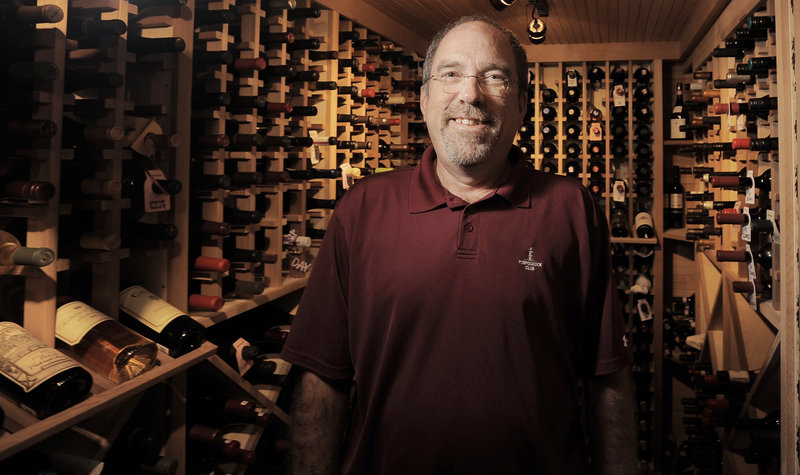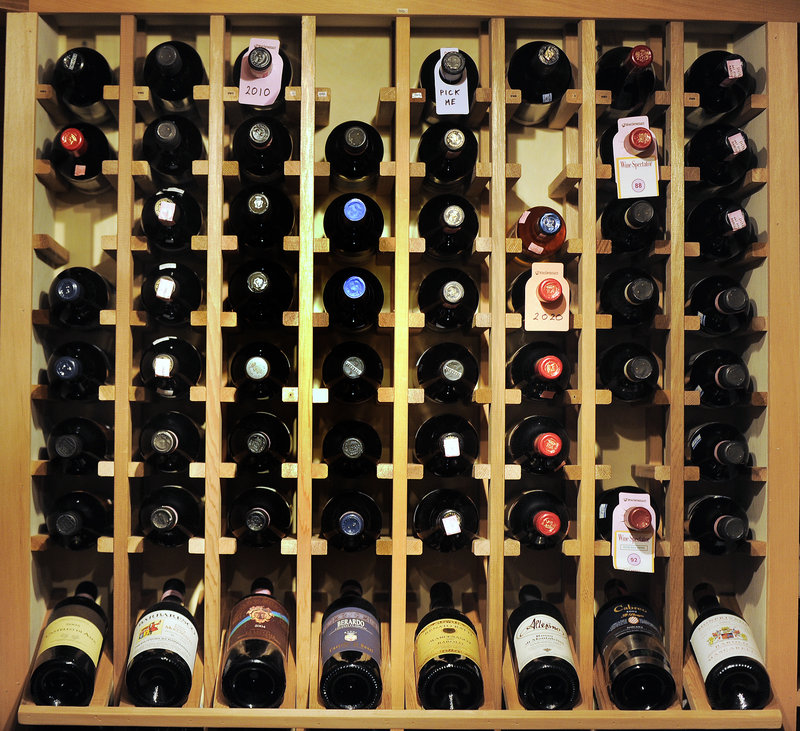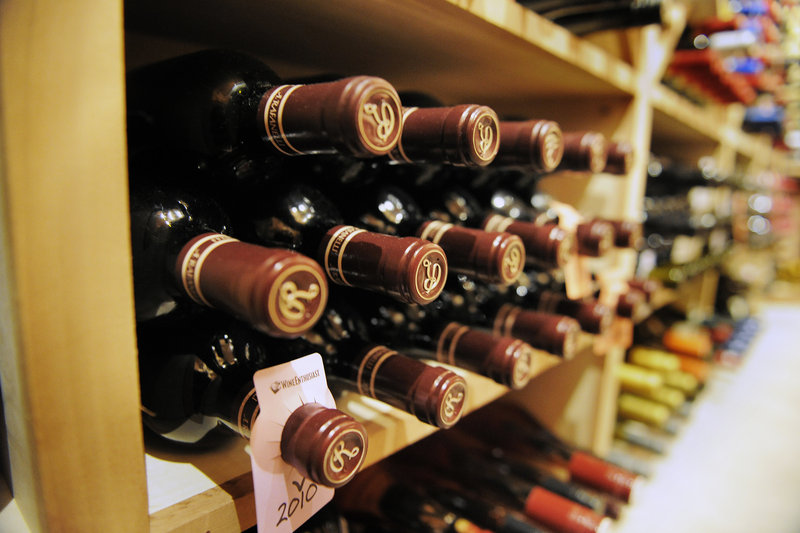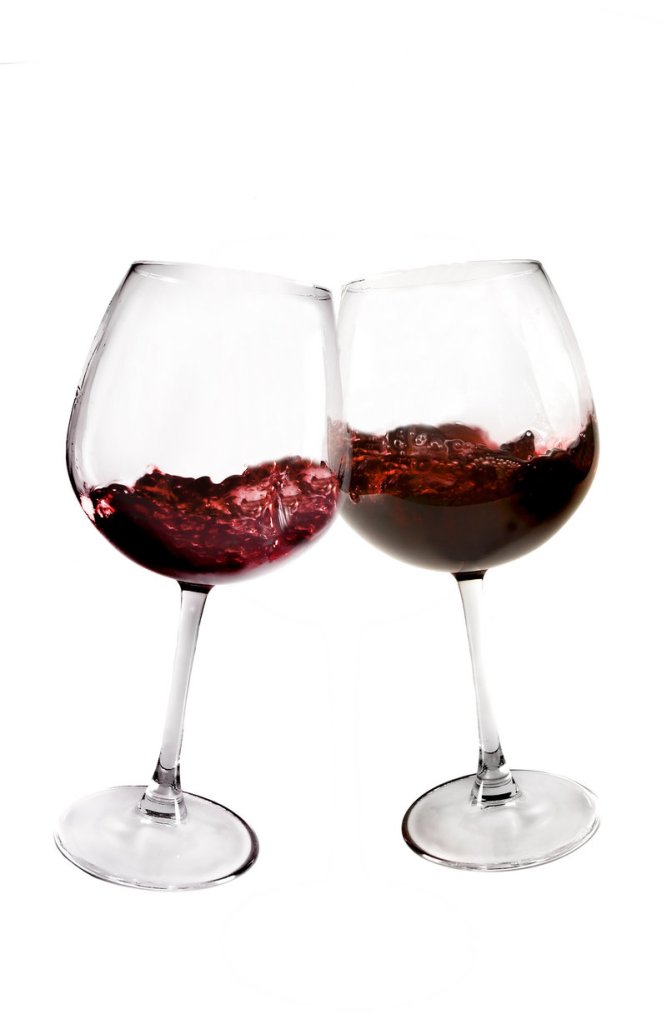SOUTH PORTLAND – When he first started drinking wine, Eric Smith of South Portland did what most casual wine drinkers do — kept a few bottles around in the kitchen or dining room, not thinking much about what the environment in his house was doing to the wine inside.
As he grew more serious about wine and it became more of a hobby, he graduated to keeping some bottles in his basement, on wine racks, where it was cooler and the temperature and humidity much more stable.
Then he purchased a wine refrigerator that could hold 100 bottles.
Today, Smith is a bona fide wine collector with a wine cellar in his basement that can hold 1,200 bottles. He is so enamored of his hobby that he’s taken his wine storage to a whole new level, linking his cellar to a computer that helps keep track of inventory and even tells him when the wine is ready to drink.
Over the years, Smith has learned a lot about the importance of proper wine storage.
“I’ve noticed a difference in a bottle of wine that’s been stored well and has aged much better than a bottle of wine that has not been stored well and hasn’t aged well,” Smith said. “They can be damaged.”
Proper wine storage is just as important for the person who buys a few bottles at a time for personal use as it is for the avid collector who spends thousands of dollars on wines to store for future enjoyment.
How should you store the wine you keep at home for dinner parties or your own drinking pleasure? Do you really need one of those wine refrigerators that are so popular these days? And when should you take the leap to a real wine cellar?
“There are three basics that you want to make sure of when you’re storing wine,” said Jen Flock, a certified sommelier and wine consultant who writes a wine blog at flockandwine.blog
spot.com. “Think about heat, direct sunlight and humidity.”
Flock says if you’re just buying wine to drink throughout the week, keeping it in a rack in a temperate part of your house, away from direct sunlight and any kind of heat source, is fine. There’s no pressing need to run out and buy a wine refrigerator.
GET OUT OF THE KITCHEN
Keep in mind that while you may have stored your Boone’s Farm in a cute little rack on top of the fridge in the 1970s, that’s one of the worst things you could do with today’s better wines. The kitchen is a terrible place to keep it since the appliances are constantly changing the temperature in the room.
Storing wine in an area that does not go above 60 degrees is best. An ideal environment is 55 degrees and 60 to 70 percent humidity.
“A lot of people put it in their basement because in Maine it stays pretty constant,” Flock said. (If you do store it in your basement, and you have a wet basement, you may need a dehumidifier.)
“If you bought it cold, keep it cold,” Flock said. “If you bought it on the rack and it’s not been in the fridge yet, putting it on your rack at home is perfectly fine. You don’t have to put it immediately in the fridge.”
Wine should be stored on its side to keep the cork wet. If the cork dries out and starts to shrink, air can get into the bottle and ruin the wine. “Heat and air are the biggest things that will kill a wine,” Flock said.
If you’ve been storing a bottle for a long time and decide you want to drink it, Flock recommends setting the bottle upright three or four days ahead of time so sediments can settle and the wine won’t be cloudy.
When should you jump to a wine refrigerator?
“More and more people are collecting wines, more and more people are buying wines in groups, more people are in wine clubs or wine tasting groups,” said Craig Cooper, a wine collector who also builds wine cellars through his business, Rainbow Construction in Cape Elizabeth. “As they do that, they’re finding opportunities to buy wine that other people have turned them onto, so all of a sudden there are 12 bottles of white in the refrigerator where there used to be two, and they have to find a place to put it.”
FROM TOASTER-SIZED ON UP
Wine fridges have grown in popularity over the past decade. They range from really small ones, about the size of a large toaster, that holds six bottles to built-in, under-the-counter models that hold 36 to 50 bottles.
These small refrigerators cost anywhere from a few hundred dollars to about $1,500. Some of them come with dual temperature controls for storing reds and whites at different temperatures.
Flock said once someone has decided they want to buy wines as an investment and hold onto them for a while, especially high-end wines, it’s time to invest in a small wine refrigerator.
“Even if you’re buying $30 to $50 bottles of wine, but they’re good enough to hold onto for five or six years and you’re buying quite a bit of them, I think it’s a smart thing to have a temperature-controlled area to put them in,” she said.
The next step up from the dishwasher-sized wine refrigerators is one of the large wine cabinets that’s the size of a food refrigerator and looks like a piece of furniture that would go in your living room or dining room.
Cooper said these units typically hold 100 to 300 bottles of wine and cost anywhere from $1,500 to $5,000. They are commonly priced in the $3,000 to $4,000 range.
But if you’re collecting enough wine to fill one of these cabinets, Flock suggests skipping this step and going straight to a wine cellar: “You’re obviously hooked.”
“You could find a small area in your house, like a closet or a part of your basement, that you could close in because the little units you can buy to make a space a temperate area, they’re $1,300 or $1,400,” she said. “Some of those cabinets I’ve seen for $3,500 to $7,000, depending on who’s making them. So if you’re going to invest that money, I would just go ahead and invest in getting racks and building a space that’s more to your liking.”
If you’re on a tight budget, Flock suggested saving money by building the racks yourself, then hiring someone to close it in and do the finishing work.
Cooper said it’s possible to do a 100-bottle wine storage area in a closet, “but quite frankly, that’s why they make those little refrigerator-like units. You couldn’t compete with the price of buying the refrigerator-type unit.”
Cooper said most people end up building wine cellars because they have become true wine collectors and buy in volume, often a case at a time. They want to take advantage of sales, and have the ability to store bottles long-term for the advantages of aging.
“I think when you get in the neighborhood of 500 bottles, then it would probably make more economic sense” to have a wine cellar, he said.
Some people have no place to put a cellar, so they just buy two of the larger wine refrigerators. And a wine cellar can also be too pricey for some budgets. Cooper says a properly built cellar with custom-made racking and humidity and temperature controls “are not inexpensive, so it is an investment for people who are investing in wine.”
“If they want to be collecting and holding 500 to 1,000 bottles, they can easily spend what would average out to be $10 to $20 a bottle for proper storage,” Cooper said. “I’ve got several 1,000-bottle wine cellars out there that cost $15,000 to build.”
WHEN A CELLAR MAKES SENSE
For true collectors, a wine cellar can be a bargain in some ways. Some $20 to $30 bottles of wine, if stored long enough, can be worth $100 by the time you pop the cork several years later.
And if you have 1,000 bottles, with an average cost of $60 to $80 a bottle, Cooper points out, you have close to $100,000 worth of wine to protect.
Cooper went through the evolution from casual drinker to wine collector himself. He was introduced to good wine by friends, and as he began to buy more, he started thinking about storage. He didn’t have room in his kitchen for an under-the-counter wine refrigerator, so he put a second refrigerator in his basement to keep his whites, and he stored his reds in the coolest part of the basement.
He started buying wine by the case, and before he knew it, he had 350 to 400 bottles stored in his basement.
About 10 years ago, he built himself a 1,000-bottle wine cellar in a corner of the basement.
“When I did it, I never thought I’d fill it,” he said. “Well now, I’m thinking about expanding it.”
Cooper also built Eric Smith’s wine cellar.
Smith’s cellar can hold 1,200 bottles and cost about $13,000 to $14,000 to build. But he actually started storing wine around 2008, with a used wine rack in the basement that held just 24 bottles.
Smith’s wine obsession began after he and his wife took a wine-tasting class at Southern Maine Community College.
“I got more and more interested in drinking wine, and I found that wow, some of these wines are special,” he said. “You can’t just go to the store and buy them every day.”
He joined the same wine club Cooper is in and began buying by the case. The wine club has eight members and is called “The Grape Nuts.” They meet regularly at each others’ homes, share tips on what to buy, and enjoy deconstructing a good glass of wine together.
Smith started adding more racks in his basement, then got a cooler that would hold 100 bottles. He thought that would be it.
“Then I started finding more great deals out there,” he said, laughing.
Smith says he considers himself a true collector, but it’s for his own enjoyment. He does not store wine as an investment and sell it later.
“I’m not going to buy a $2,000 bottle of wine and maybe sell it in two years for $3,000,” he said. “No, I’m going to buy a $20 bottle of wine and drink it in three years and ‘Wow, this tastes like a $100 bottle of wine.’ “
Smith loves West coast pinot noirs and is “fascinated” by Italian wines. He’s just started exploring Chilean varietals. All of the wines are organized by category in his cellar — American cabs, French, Oregon pinot noirs, Italian wines.
ONLINE TRACKING
Smith has linked his wine cellar to an online cellar tracking program. A random check of the program last week showed that he currently has 1,054 bottles in his cellar, with another 100 bottles pending. The program told him that he’s consumed 1,871 bottles of wine since he signed up, and purchased 3,025 bottles.
“There are thousands and thousands of people (using this program), with hundreds of thousands of bottles of wine,” Smith said. “If somebody tries a bottle of wine and does some tasting notes on the website for it, if it happens to match a bottle of wine that I have in my cellar, I get those notes.”
Smith also prints out labels for each bottle he buys. The label tells him what the wine is; the “drinking window” (2007 to 2013, for example) so he’s not just guessing when a wine is ready; when and where he bought it; what he paid for it; and the average value, so he can see if he made or lost money. If a rating is available, it will be on the label too. Each label also has a bar code for easy scanning into the computer.
Every once in a while, he prints out a spreadsheet that tells him all the wines he has, by varietal, and which ones are ready to drink right now. “Or I’ll look at what we have at a particular meal, and I’ll say I want a South African Savignon Blanc,” Smith said. “That would go really nice with this meal.”
Asked if he would ever expand his storage space, Smith said he’s trying to keep a cork in his wine habit.
“That’s easier said than done, but I can only drink so many bottles of wine a day,” he said.
Staff Writer Meredith Goad can be contacted at 791-6332 or at:
mgoad@pressherald.com
Twitter: Meredith Goad
Send questions/comments to the editors.







Success. Please wait for the page to reload. If the page does not reload within 5 seconds, please refresh the page.
Enter your email and password to access comments.
Hi, to comment on stories you must . This profile is in addition to your subscription and website login.
Already have a commenting profile? .
Invalid username/password.
Please check your email to confirm and complete your registration.
Only subscribers are eligible to post comments. Please subscribe or login first for digital access. Here’s why.
Use the form below to reset your password. When you've submitted your account email, we will send an email with a reset code.